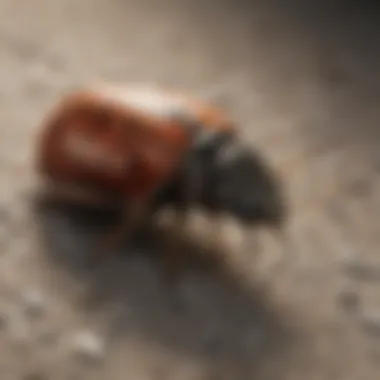Understanding Carpet Beetle Allergic Reactions


Intro
Carpet beetles are more than just a nuisance in homes; they can trigger allergic reactions in many individuals. Understanding these pests is essential for effective management. As carpet beetles thrive in warm environments, their presence is commonly felt in households across different regions. Sensitive individuals may experience varying degrees of allergic symptoms. This article dives deeper into the biology of carpet beetles, the allergic responses they can elicit, and strategies for managing their presence.
Understanding the Pest
Identification
Carpet beetles belong to the family Dermestidae. There are several species commonly encountered in homes, including the common carpet beetle (Anthrenus scrophulariae) and the varied carpet beetle (Anthrenus varius). Adult carpet beetles are small, generally ranging from 1/8 to 1/4 inch in length, with oval bodies usually covered in scales that can vary in color. Common colors include black, brown, and orange. Larvae, which are hairier and more elongated, are often a sign of trouble, as they feed on natural fibers found in carpets, clothing, and upholstery.
Life Cycle
Understanding the life cycle of carpet beetles helps in managing them effectively. The cycle begins when adult female carpet beetles lay eggs in suitable areas. After a few weeks, eggs hatch into larvae, the most damaging life stage. The larvae can take several months to mature, often depending on environmental conditions. Once they pupate, they emerge as adult beetles ready to reproduce. Timing of both hatching and pupation can vary with temperature, making management strategies critical during warmer months.
Pest Prevention Strategies
Environment Modification
Modifying the habitat is a proactive way to control carpet beetles. Reducing clutter where infestations can start is vital. Regular cleaning, such as vacuuming floors and upholstery, can remove eggs and larvae. Use a vacuum cleaner with a HEPA filter to catch small particles effectively.
Moreover, keeping natural materials away from direct sunlight will deter breeding. Storage of wool, cotton, and silk items in airtight containers can minimize attraction. Effective moisture control also plays a crucial role, as carpet beetles prefer humid environments.
Physical Barriers
Installing screens on windows and doors can help prevent carpet beetles from entering the home. Regular inspection of items brought into the house is also key. Items such as second-hand clothing or furniture should be thoroughly examined before bringing them inside. In addition, using sticky traps can help monitor populations and identify potential sources of infestation.
Control Methods
Chemical Control
In cases of significant infestations, chemical control may be necessary. There are various insecticides available that effectively target carpet beetles. Products containing pyrethroids are suitable as they are relatively safe for indoor use. Follow all instructions on the label to ensure proper application and safety.
Biological Control
An alternative to chemical control is biological management. Introducing natural enemies, like certain parasitoid wasps, can help control beetle populations. Though this method requires careful planning and understanding of ecological interactions, it minimizes chemical exposure in the home environment.
"Understanding carpet beetles and their behavior is the first step to effective management and prevention."
Prologue to Carpet Beetles
Understanding carpet beetles is essential because these pests are frequently found in homes. They can lead to significant allergic reactions, particularly in sensitive individuals. With increasing awareness about health and well-being, it is crucial to recognize how these insects impact our living spaces and health.
Carpet beetles, although small, are savvy at infiltrating homes and causing not only damage to fabrics but also posing health risks. Their presence may go unnoticed until symptoms start appearing. This can lead to discomfort and a decline in overall quality of life. Thus, it is beneficial to have knowledge about their habits and the way they can trigger allergic reactions in humans.
The following sections will provide insights into the morphology of carpet beetles, their living environment, and behavior. A thorough understanding can aid housewives and homeowners in identifying these pests, thus enabling proactive measures. This knowledge is not only about prevention; it is about empowering individuals to create a healthier and safer home environment.
Overview of Carpet Beetles
Carpet beetles belong to the family Dermestidae. They generally feed on natural fibers, such as wool, silk, and fur. Adult beetles are usually small, and they can vary in color, often appearing as brown or black with various mottling. These insects typically measure between 1/10 to 1/8 of an inch in length. They are often misidentified as other pests, making awareness of their specific characteristics essential.
Their life cycle includes four stages: egg, larva, pupa, and adult. The larval stage is particularly harmful as it is during this phase that they consume and damage fabrics in the household. Adult carpet beetles are drawn to light and can often be found near windows and light sources.
Habitat and Behavior
Carpet beetles are known to adapt to various environments, but they prefer warm and dry areas. They often make their home in places where fabric accumulation occurs, such as closets, attics, and amongst old clothing. These spaces provide the ideal conditions for breeding.
In terms of behavior, carpet beetles are not particularly aggressive. However, they can easily spread throughout a home, especially when they find suitable conditions for nesting. Moreover, certain types of carpet beetles, like the varied carpet beetle, are notorious for damaging upholstery and household items.
Understanding where carpet beetles thrive can provide essential insights for preventative measures. Homeowners should be vigilant in inspecting vulnerable areas regularly. Utilizing preventive measures can significantly reduce the risks these pests pose.


Understanding Allergic Reactions
Allergic reactions are significant because they can directly affect quality of life. When individuals are exposed to allergens, their immune systems may respond inappropriately. This can lead to various symptoms, some of which can be severe. Recognizing how allergies work is vital, especially in the context of carpet beetles, which are common indoor pests. Understanding allergic reactions helps individuals identify symptoms early and take steps to manage their health effectively.
What Constitutes an Allergic Reaction?
An allergic reaction occurs when the immune system identifies a substance as harmful. This leads to the production of antibodies. The body reacts by releasing histamines and other chemicals that cause symptoms. Common symptoms include sneezing, itching, and swelling. In some cases, reactions can be more severe, leading to anaphylaxis.
Individuals might experience varying degrees of reactions based on their sensitivity to the allergen. The location and extent of exposure can also influence the severity. For example, carpet beetles shed skin, eggs, and feces that may trigger allergic responses. Understanding these processes is essential for gaining control over allergic reactions.
Types of Allergens
Allergens are substances that can cause allergic reactions in susceptible individuals. There are numerous types of allergens, including:
- Environmental allergens: These include pollen, pet dander, mold, and dust mites.
- Food allergens: Certain foods like peanuts, shellfish, and dairy are common triggers.
- Insect allergens: Pests like cockroaches and carpet beetles fall into this category.
- Contact allergens: Substances that cause skin reactions upon contact such as latex or certain metals.
Understanding these categories helps in identifying potential triggers, allowing for better management of allergic conditions. Being aware of the various types of allergens is crucial, especially in a household where allergies might be prevalent.
Carpet Beetles as Allergens
Carpet beetles are often underestimated pests. Their role as allergens in homes is significant, especially for those who are sensitive. Understanding this aspect is crucial for individuals and families who may be affected. When carpet beetles infest, they do not only damage fabrics but also release particles that can trigger allergic reactions.
How Carpet Beetles Trigger Allergies
Carpet beetles produce different allergens from various stages of their life cycle. The larvae, in particular, are problematic. They feed on natural fibers like wool, silk, and feathers. As they consume these materials, they leave behind shed skins, feces, and other debris. These remnants are what becomes airborne and can enter the human respiratory system.
Simply coming into contact with these allergens can provoke responses in sensitive individuals. The immune system identifies these particles as threats, leading to symptoms ranging from sneezing to more severe reactions. Furthermore, adult carpet beetles can also produce allergens, but they are less problematic than their larvae. The key takeaway is that both life stages of carpet beetles contribute to potential allergic reactions, which makes them a notable concern.
Factors Influencing Allergic Reactions
Several factors can influence how severe a person's reaction to carpet beetles may be. These factors include:
- Individual Sensitivity: People vary in their sensitivity levels. Some might have mild reactions, while others may experience severe symptoms.
- Extent of Infestation: A larger number of carpet beetles lead to a higher accumulation of allergens, increasing the probability of reactions.
- Environmental Conditions: High humidity and poor ventilation can exacerbate allergic responses. Allergens flourish in environments where moisture levels are high.
- Existing Allergies: Individuals with allergies to other substances may find their symptoms intensified when exposed to carpet beetle allergens.
Being aware of these factors can help individuals take preventive measures. Reducing exposure to carpet beetles not only alleviates symptoms but also improves overall health.
"Awareness and preventive actions can significantly reduce allergic reactions caused by carpet beetles."
Overall, recognizing how carpet beetles function as allergens is essential. With this understanding, effective management strategies can be implemented, ultimately leading to a healthier living environment.
Common Symptoms of Carpet Beetle Allergic Reactions
Recognizing the common symptoms of carpet beetle allergic reactions is crucial for timely intervention and management. This section will delve into the specific symptoms associated with carpet beetle allergies, emphasizing their significance in identifying potential health risks. Understanding these symptoms helps housewives and homeowners act swiftly, protecting their families from further exposure and reinforcing a healthier living environment.
Skin Reactions
Skin reactions are among the most immediate and visible allergic symptoms. These can manifest as redness, itching, or welts on the skin once an individual comes into contact with carpet beetle allergens. These allergens are often found in the larvae and feces of the beetles, which can easily spread throughout a residence, especially in areas where carpets and textiles are found.
Common skin reactions include:
- Eczema: This condition can worsen due to carpet beetle exposure, leading to discomfort and visible irritation.
- Hives: Raised and itchy welts can appear, often triggering scratching and further irritation.
It is essential to recognize these symptoms early. Ignoring skin reactions can lead to secondary infections and prolonged discomfort. Individuals should seek to identify whether these reactions correlate with carpet beetle presence as soon as symptoms arise.
Respiratory Symptoms
Respiratory symptoms can complicate an allergic reaction, making it imperative to monitor them closely. Exposure to carpet beetle allergens may cause coughing, sneezing, and nasal congestion. These symptoms can be particularly troublesome for individuals with pre-existing respiratory conditions, such as asthma or allergies to other triggers.
Specific respiratory symptoms include:
- Chest tightness: This sensation can lead to breathing difficulty in more sensitive individuals.
- Allergic rhinitis: This manifests as nasal inflammation due to a reaction to the allergens, resulting in runny nose and itchiness.


Understanding the link between respiratory symptoms and carpet beetle exposure allows affected individuals to take necessary actions, such as minimizing exposure and consulting healthcare professionals for advice.
Gastrointestinal Issues
While less common than skin and respiratory symptoms, gastrointestinal issues can occur with carpet beetle allergies. An allergic reaction may sometimes cause nausea, stomach cramping, or diarrhea.
The link between allergens and these gastrointestinal symptoms can be attributed to the body’s immune response, triggered by the allergens entering the digestive system. It's crucial for individuals experiencing such symptoms to monitor their health and consider exposure to carpet beetles as a possible source.
Seeking medical advice in relation to gastrointestinal symptoms may help discern carpet beetle allergies from other health issues, ensuring appropriate treatment is established.
Overall, awareness of these common symptoms is essential. Early identification and management can mitigate risks associated with carpet beetle allergies, benefitting the health and wellbeing of every household.
Diagnosing Carpet Beetle Allergies
Diagnosing carpet beetle allergies requires careful evaluation, as it plays a vital role in managing allergic reactions effectively. People often overlook these allergens, mistaking symptoms for other conditions. Recognizing the presence of carpet beetles and understanding their link to specific health issues is critical.
Appropriate diagnosis helps identify triggers. Identifying carpet beetles as a cause allows individuals to take informed steps towards treatment and prevention. This process involves more than just observing symptoms; it requires professional assistance to confirm if carpet beetles are indeed the source of allergic reactions.
Medical Consultation Process
A medical consultation is the first step to diagnose carpet beetle allergies. It is essential to consult an allergist or dermatologist when unusual symptoms present themselves. These professionals have the knowledge to assess allergy history and perform necessary evaluations.
During the initial visit, the doctor will typically ask various questions:
- When did the symptoms begin?
- Where do you spend most of your time?
- Have you noticed any particular triggers?
This information is crucial in determining if carpet beetles are the culprits of the allergic reactions. A physical examination may also be conducted to observe any skin reactions. This hands-on approach aids in assessing overall health conditions.
After the consultation, the doctor may recommend follow-up tests for a clearer diagnosis.
Allergy Testing Methods
Once a medical consultation is established, specific allergy testing methods may be employed. These tests help identify the allergens responsible for allergic reactions. Common tests include skin prick tests and blood tests.
- Skin Prick Test:
This method involves applying small amounts of various allergens, including carpet beetle proteins, to the skin. The doctor monitors for reactions, determining if the individual is allergic to carpet beetles. - Blood Test:
In cases where skin testing is not appropriate, a blood test can measure specific IgE antibodies related to carpet beetles. A higher level of these antibodies indicates a potential allergy.
These testing methods can provide a definitive answer regarding carpet beetle allergies. They are essential for paving the way towards suitable management and treatment plans, tailored to the specific needs of the individual.
"Accurate diagnosis is the cornerstone for managing allergies effectively. Without it, individuals may continue to suffer needlessly."
Identifying carpet beetle allergies through professional consultation and testing is a significant step toward reclaiming wellness. It enhances the understanding of one’s health and facilitates implementing effective management strategies.
Management and Treatment of Allergic Reactions
Managing carpet beetle allergic reactions is crucial for those affected. It goes beyond just addressing symptoms. Effective management reduces the impact on daily life and enhances overall well-being. Understanding how to treat and manage these reactions helps individuals regain control over their environment. It is also important because it prevents complications that could arise from untreated allergies, such as chronic respiratory issues or severe skin reactions.
Over-the-Counter Treatments
For individuals experiencing mild allergic reactions, over-the-counter treatments can provide relief. Antihistamines like Benadryl or Claritin are commonly used. They work by blocking histamine, a substance in the body that causes allergic symptoms. Users often find symptom relief within a few hours. Additionally, topical creams such as hydrocortisone are suitable for managing skin irritations. These creams help relieve redness and itching.
However, it is essential to read labels carefully to avoid potential side effects. Some antihistamines may cause drowsiness. This can be problematic for individuals who need to stay alert. Therefore, choosing a product that suits one's lifestyle is important.
Prescription Medications
In cases where over-the-counter options are insufficient, consulting a healthcare professional is advisable. Prescription medications may become necessary for more severe allergic reactions. Corticosteroids, for example, are commonly prescribed to reduce inflammation and alleviate severe symptoms. These medications can be taken in various forms, such as pills or inhalers.
Allergy shots, also known as immunotherapy, are another option. They work by gradually desensitizing the body to allergens over time. This method may take several months of treatment, but it can be effective for long-term relief. Patients should discuss their options thoroughly with a healthcare provider to ensure the most effective approach for their situation.
Natural Remedies and Alternatives
Some individuals prefer to explore natural remedies alongside or instead of conventional treatments. Options like saline nasal rinses can help clear allergens from nasal passages. Herbal teas containing ingredients such as ginger or chamomile may also be soothing. While these remedies may not provide the same level of relief as medications, they can complement treatments by promoting overall health.


It is crucial to consult with a healthcare professional before trying any natural remedies. Some herbs can interact with medications or may not be suitable for everyone. Therefore, understanding one's health status is essential.
Effective management of carpet beetle allergies combines medical advice, appropriate treatments, and environmental strategies.
Prevention Strategies
Understanding how to prevent carpet beetle allergies is crucial for maintaining a healthy living environment. By focusing on key prevention strategies, individuals can significantly reduce their risk of exposure to these pests and subsequent allergic reactions. The following sections will elucidate specific tactics, offering practical guidance that is easy to implement in everyday life.
Maintaining a Clean Environment
A clean environment is the first line of defense against carpet beetle entry and proliferation. Regular cleaning can diminish potential habitats for these pests. Here are some practical steps:
- Vacuuming: Routine vacuuming of carpets, rugs, and upholstery is essential. Pay attention to corners and under furniture, where dust and debris often accumulate.
- Dusting: Use a damp cloth to dust surfaces, which prevents dust mites and beetle larvae from settling.
- Laundering Fabrics: Regularly wash curtains, cushion covers, and bedding in hot water to kill any larvae that might be present.
Implementing these practices not only keeps carpets clean but also removes food sources for carpet beetles. A consistently clean home minimizes allergens and creates an inhospitable environment for pests.
Regular Inspections and Cleaning
Along with cleaning, conducting regular inspections can help spot potential carpet beetle infestations before they become a major problem. Consider these methods for effective inspections:
- Monthly Checks: Regularly inspect nooks, crannies, and seldom-used areas like attics and basements.
- Identify Clues: Look for signs of infestation, such as shed skins, fecal matter, and visible larvae. These indicators can provide early warnings about deeper infestations.
- Inspect Storage Areas: Areas such as closets and storage boxes often harbor hidden pests. Regularly check these places, especially if they contain natural fiber items like wool or silk.
By catching infestations early, you save time and energy in dealing with larger outbreaks later.
Using Pest Control Solutions
When preventive measures are not enough, it may be necessary to explore pest control solutions. There are various options that can be pursued based on the severity of the infestation:
- DIY Treatments: Over-the-counter insecticides are available. Ensure the product is effective specifically against carpet beetles and follow application guidelines closely.
- Professional Services: If the infestation is severe, a professional pest control service is advisable. They can assist in thorough inspections, targeted treatments and preventive strategies that may not be obvious to the average homeowner.
- Integrated Pest Management: This approach combines multiple strategies for effective long-term control. It may include biological controls, cultural practices, and mechanical traps alongside chemical solutions.
Using the right pest control solutions reduces the overall risk of allergies associated with carpet beetles. It is essential to evaluate the safest options for both health and the environment.
When to Seek Professional Help
Carpet beetle allergies can lead to severe discomfort and health issues for some individuals. Understanding when to seek professional help is crucial. This section discusses specific elements that indicate the need for expert intervention, the benefits of professional support, and considerations to keep in mind.
Identifying Severe Reactions
Severe allergic reactions to carpet beetles can manifest quickly and sometimes dangerously. Recognizing these reactions is vital for ensuring immediate treatment. Common signs that indicate a severe reaction include:
- Difficulty Breathing: If you experience wheezing, choking, or shortness of breath, this signals a significant allergic response.
- Widespread Skin Reactions: Hives or swelling that covers a large area of the skin can indicate a severe allergy.
- Anaphylaxis: This is a life-threatening condition characterized by a rapid drop in blood pressure, swelling of the throat, and potential loss of consciousness. Symptoms include:
- Rapid heartbeat
- Nausea or vomiting
- Confusion or dizziness
In any of these cases, it is imperative to seek medical help immediately. Delaying treatment can worsen the reaction and lead to severe consequences.
Choosing the Right Pest Control Service
Finding an effective pest control service to address carpet beetle problems is also important. Not all services are created equal, so consider the following aspects:
- Reputation and Reviews: Look for companies with positive feedback from previous clients. Websites like Reddit can provide community insights and experiences.
- Treatment Methods: Ensure the company uses safe and effective methods for removing carpet beetles, especially if you have young children or pets.
- Licensing and Certification: A reputable pest control service should have valid licenses and certifications that ensure they meet industry standards.
- Follow-Up Services: Good pest control services offer follow-up appointments to ensure the problem is thoroughly addressed, which can help in preventing future infestations.
Ultimately, the decision to seek professional help should be based on the severity of symptoms and the effectiveness of DIY pest control methods. Always put health and safety first.
End
The conclusion serves as a vital component of any comprehensive discussion on carpet beetle allergies. It encapsulates the key findings and emphasizes their relevance to the readers, particularly housewives and homeowners. The significance lies not only in summarizing the content but also in reinforcing the importance of awareness regarding carpet beetles and their potential effects on health.
Summarizing Key Points
Understanding the biology and behavior of carpet beetles is crucial. These pests contribute to allergic reactions in susceptible individuals. The allergic reactions can manifest in various forms such as skin irritations, respiratory problems, and even gastrointestinal issues. Identifying these reactions is the first step towards effective management. Diagnostic methods and treatments are available, which include both over-the-counter and prescription options.
Prevention strategies are paramount. Keeping a clean environment, conducting regular inspections, and utilizing pest control solutions can substantially reduce the presence of carpet beetles. Understanding these elements provides a clearer pathway to maintaining a healthier living space.
Final Thoughts on Carpet Beetle Allergies
Being informed translates to proactive measures. It is crucial for individuals to recognize the signs of carpet beetle allergies and act swiftly. Seeking medical advice is essential when symptoms escalate. Moreover, implementing preventive strategies can mitigate risks associated with these pests. Thus, fostering a healthier household environment is not merely about managing pest presence; it's about prioritizing well-being.







